构建合作共享、数字包容的未来
——英国利兹图书馆馆长访谈
2021-11-12安德里亚·埃里森,屠淑敏,殷叶玲
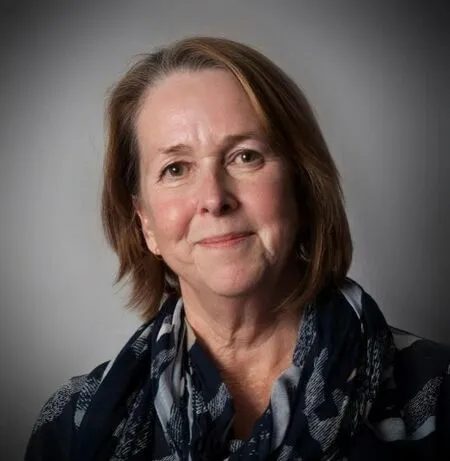
安德里亚·埃里森
访谈对象:安德里亚·埃里森(Andrea Ellison),英国利兹图书馆馆长。曾经在拉夫堡大学学习图书馆和信息科学,并担任学校图书馆员、儿童和青少年图书馆服务负责人。2017年6月加入利兹市议会,担任利兹图书馆馆长,目前是英国图书馆合作组织Libraries Connected(LC)①约克郡亨伯地区的区域主席,对发展区域共享服务特别感兴趣。
本刊:首先想问一个有关疫情的问题。2020年爆发的新冠疫情给全世界都带来了巨大的影响,您和您的图书馆是如何度过这段最艰难的时间的?现在疫情有了好转,世界各地图书馆的服务也在逐渐恢复中,您觉得疫情给图书馆带来的最大的变化是什么?
安德里亚·埃里森:我们应对新冠疫情的做法与我们国家的大部分图书馆类似。
(一)做好用户支持服务
疫情初期我们的许多员工被分配到了其他的岗位,比如支持食品银行和热线服务电话的工作。与此同时,我们的服务也从“面对面”更多地转向了“数字”的形式,包括提供更多用户可以在家访问的数字资源。
在因疫情封锁的第一阶段,我们加入了多个图书馆当局制定的一项倡议,并推出了“保持联系”项目,给我们的9 500多位老用户打电话,让他们随时了解图书馆服务的变化;支持他们能够以数字的形式访问图书馆和一些其他机构的服务;确保他们知道必要时从哪里获得帮助或支持(例如 COVID 帮助热线)。
这项行动获得了用户非常积极的反馈:
“今天早上我接到了你们的电话,询问我是否还好,能否应对当前的封锁,并且向我介绍了最新的图书馆可用服务。这是非常有价值的举动,你们为我做了这么多,请接受我的感谢。”
“你们让我迷上了有声读物。我现在每周大约听两本书。听有声读物最棒的是你可以同时做其他的事,这让人感觉很放松。我用耳塞听书,同时做很多缝纫工作。可选的有声读物也很多。”
“你们做得特别出色。非常感谢所有图书馆员的辛勤工作,在这个可怕的时刻,让我们仍然可以获得信息并且阅读。”
我们与一位对电子书、电子杂志以及本地和家族历史非常感兴趣的用户进行了长时间的交谈,他说,“非常感谢,这是我这段时间以来接到的最美好的电话”。对于我们提供的预约图书服务,一位用户说“如果没有这项服务,我感觉我会活不下去,我会一直处于焦躁不安的状态中”。
(二)支持用户发展数字技能
新冠疫情暴露的最大问题之一是我们的数字排斥程度,以及公民面临的日益严峻的挑战,包括无法获得必要的支持、心理健康状况恶化和经济困难。这促使我们重新审视利兹图书馆的数字支持服务,我们现在将其更名为#Digital121。
#Digital121的核心是图书馆的电话咨询服务,它捕捉并指导图书馆用户和合作伙伴的数字支持请求,通过图书馆自身的服务或推荐的其他服务,将它们的需求与最合适的信息匹配起来。虽然#Digital121是一项通用服务,但主要还是针对那些数字技能较低的人,他们以前可能从未能自己使用这些设备,需要全面的指导。一个专门的#Digital121推广活动专注于提供数字支持,鼓励公民加强联系,以便我们的图书馆员团队可以帮助他们发展数字技能并建立信心。在疫情和当下的限制期,我们通过电话或 Zoom远程提供该项服务。2020年5月至2021年5月间,我们共提供了200多次此类服务。
我们还加大了对数字资源的投资,增加了电子书目录并购买了新资源,例如:Niche Academy ——一系列免费的在线教程,包括如何设置电子邮件帐户、使用社交媒体、使用图书馆在线资源(例如电子书、商业支持和家谱检索)等的技能培养。该资源自2020年4月推出以来,引起了人们极大的关注,访问次数超过13 500次;Press reader——RB Digital提供的电子报纸服务,让我们的用户可以免费获取最新的新闻。从3月27日投入使用到3月底,共有137篇文章的634次下载量,包括一些不是以英文出版的全球性的报纸。
用户对所有这些活动、数字支持项目和新资源给予了积极的评价:
“能够访问电子书是我的生命线。它现在是我手机上最好的应用程序了!”
“电子报纸是一项很棒的服务,即使在家里我也可以使用。”
“很高兴在家里我也可以找到我的祖先的血统。”
“图书馆员真是太棒了——资源非常好,并且很容易掌握!”
随着限制令的逐渐解除,我们计划在加强远程服务的同时重新引入面对面的服务方式以扩展#Digital121项目。我们将专注于提供小组研讨,支持用户管理他们的健康和福祉、保持在线安全以及研究他们的本地和家族历史。我们还将招募数字志愿者来支持我们的文献传递和能力构建。
(三)开发我们的数字图书馆产品——资源和在线活动
在封锁的最初阶段,数字内容爆炸式增长,似乎有势不可挡之势。除了引入Niche Academy和电子报纸之外,作为信息领域的专家,我们还利用专业技能在官网上创建了一个新的虚拟图书馆,不但展示我们自己最好的在线内容,还提供了其他优秀网站的指引。同时还为我们的教育合作伙伴提供优质资源信息,并定期向学校发送通讯。此外,我们开发了一系列全新的虚拟活动,以与图书馆在信息、教育和娱乐方面更广泛的目标保持一致。其中的一些重点项目包括:
大英图书馆展览,“未完成的事业:为妇女权利而战”。2020年底,作为我们与大英图书馆(The British Library,BL)合作的一部分,我们策划了一个虚拟展览和活动项目,以庆祝BL的展览“未完成的事业:为妇女权利而战”。我们的在线展览突出了利兹对性别平等运动的独特贡献,同时展示了与更广泛的妇女权利历史相关的重要书籍。展览跨越300多年,以1669年凯瑟琳·菲利普斯的诗歌开篇,到1970年代和80年代的激进主义,最后以当代地方口语艺术家的作品终章。与BL合作举办的周末活动包括工作坊、作者演讲和表演,吸引了来自世界各地的800多人参加。为了庆祝这次展览,“12号工作室”②与年轻诗人、著名文学活动家、作家和剧作家卡蒂查·伊布拉希姆共同举办了5场诗歌工作坊和指导课程。工作坊探讨了女性的声音、行动主义和为争取更公平世界的斗争。参与者的诗歌被改编为口语表演电影,并在一个特别的现场口语展演中展示。这一展演包括了卡蒂查和诗人/活动家Suhaiymah Manzoor-Khan之间的专题讨论,随后是“周日实践”③的口语表演。有300多人通过社交媒体参与了我们这次特别的展演活动,来自约克郡的观众最多,其次是伦敦。
BBC(British Broadcasting Corporation,英国广播公司)的“塑造我们世界的小说”。BBC全国性项目“塑造我们世界的小说”其中的一个内容是探索游戏与讲故事之间的联系,包括如何创建文学密室逃脱游戏的研讨会,探讨BBC小说列表中那些小说背后的真实历史、家庭动漫活动,讨论图书馆和博物馆如何使用游戏活动吸引新的用户等,这一切促成了为期两天的“游戏果酱”活动。这一活动要求人们设计一款受BBC小说列表启发的数字或实体游戏,参加者可以访问利兹图书馆特别收藏的图片以获取灵感。这个周末的图书馆重大事件是虚拟现实艺术家罗茜·萨默斯的现场混合现实表演,她将纳尼亚世界带入了我们的现实生活。提交的游戏都可以在itch.io页面上查看,所有的事件都会被记录下来并添加到YouTube频道。
另外我们还开展了一个以艺术活动和文化活动为基础的项目,包括艺术活动:我们举办了一系列受艺术家约瑟夫·康奈尔的雕塑和集合艺术“盒子中的世界”启发的工作坊。在这些工作坊中,我们将物品组装在一个盒子里,以此来捕捉小说、故事、旅行或某一个地方的灵感。最终的艺术作品可以在我们和合作伙伴Space2共同举办的展览中在线观看;文化活动:我们和利兹市的读者和作家团体合作,在社交媒体上举行了一系列活动。我们希望读者在社交媒体上分享那些对他们产生了重大影响的小说,并且尽可能地挑战阅读100本书。对于作家,我们设置了一些写作挑战,参与者还可以参加由当地作家艾莉森·塔夫脱教授的写作课程。这些参与者撰写的作品目前都在我们的电子书平台上展示,你可以在我们的网站上读到更多的相关内容。
(四)提供商业及知识产权服务
尽管采取了数字化的方式,但是对于一些关键的服务领域,我们仍然像往常一样提供服务。例如,2020年我们的商业和知识产权服务迅速地转向了在线模式,以确保本地企业在疫情期间能够得到持续的支持。这些服务包括:
(1)通过社交媒体和合作伙伴渠道加强信息传递,让当地的商业团体知道我们的服务还将继续,图书馆支持企业通过电子邮件和电话进行信息查询。
(2)将面对面的咨询转变为电话咨询。事实证明这一形式特别受欢迎,我们为此增加了额外的研讨时间。
(3)提供在线资源访问,确保我们的团队能够高效地处理电子邮件和电话咨询。需要查阅这些资源的用户还可以预订一对一的Zoom会议,图书馆提供屏幕共享服务。
(4)将之前的面对面活动改为网络研讨会的形式,以确保我们的商务和知识产权服务平台能够一如既往地提供服务支持。
(5)随着企业寻求适应新的工作和营销方式,我们的网络研讨会也调整了关注方向,聚焦新兴领域开展额外的网络研讨,重点是在线销售、社交媒体和初创业暑期学校。
(五)实现了一次成功的重启
我们与大英图书馆合作开展了重启对话项目,旨在支持企业转型,面向未来,实现增长。这一项目提供了访问一系列新的网络研讨会以及与专家顾问一对一咨询的机会。我们最成功的重启项目之一是以音乐行业为关注重点的在线活动,该行业受疫情的影响尤为严重。这一活动与曼彻斯特图书馆合作进行,邀请了来自该领域的音乐家和其他代表参加,并就如何应 对疫情和向前发展展开了热烈的讨论,超过120人参与了现场直播。
(六)制作了总结短片
我们制作了一部关于过去一年以及更长时间活动的短片作为总结,可以在Youtube上观看。
本刊:BBC曾报道了过去十年英国公共图书馆预算紧张的情况,十年间英国公共图书馆的数量也有明显的下降。利兹图书馆有没有受到这方面的影响?疫情的爆发是否加深了英国公共图书馆的经费问题?图书馆又该如何去应对?
安德里亚·埃里森:目前,利兹市共有34家图书馆,这几年没有图书馆关闭。然而,作为2011年7月至2013年7月“图书馆审查”(新章)的一部分,利兹有16家图书馆被关闭,3家转入社区管理,另外还有3家小型图书馆也在2015年关闭。
许多地方政府多年来一直面临着重大的财政挑战,而新冠疫情无疑加剧了这一状况。在上一个财政年度,利兹市议会被要求大幅节省预算,包括图书馆服务在内的所有服务都将在这一考虑之内。然而,我们还没有走到要关闭图书馆这一步。我们都认可这一事实:目前利兹在运行的34家图书馆都在为主要的社区服务,并且采用了“精益思维”的方法,通过高效的工作实践来节省开支,举措包括:
(1)审查图书馆服务的人员配置,创建更精简的结构,并引入通用的职位描述,以增加灵活性。
(2)作为公众咨询的一部分,对开放时间进行审查,审查的结果包括取消周日开放,全市大部分图书馆每周只安排一个晚上开放。为了与新的开放时间保持一致,制定了更有效的员工轮岗时间模式。
(3)减少在图书上的支出。
(4)采用性价比更高的服务提供方法,例如减少印刷报纸的订购并引入电子报纸。
我认为,当面对预算挑战时,图书馆应该创造性地思考如何提高内部工作效率,而不是单纯地关闭图书馆或减少资源的数量。然而,随着预算的不断缩减,提高效率也变得越来越困难。因此,我认为应该利用这段时间来证明,图书馆可以在控制疫情和疫情后的复原中发挥重要的作用,这一点非常关键。
Libraries Connected在其出版的《图书馆:复苏的重要部分》一书中确定了五个关键领域,认为图书馆可以在帮助个人和社区克服新冠危机的影响方面发挥核心作用:(1)经济复苏,为求职者和企业经营者提供帮助和培训;(2)为儿童,尤其是在家学习困难的特殊需求儿童提供教育支持;(3)缓解弱势群体的隔离焦虑,帮助人们重新建立当地联系;(4)为缺乏IT技能或无法访问互联网的居民提供数字包容服务;(5)建立文化伙伴关系,帮助当地艺术家和艺术组织继续他们的工作。
我们将这五个广泛的主题作为利兹图书馆重新恢复计划的战略支持,并力图确保我们的所有活动与这些关键优先事项中的一个或多个保持一致。
本刊:利兹图书馆是一个由多个图书馆组成的图书馆集群,您能否介绍下这个集群是如何保持高效运作的?尤其是在经费和人员管理方面?利兹的图书馆又是如何和英国其他地区的图书馆以及国家层面的图书馆合作的?
安德里亚·埃里森:利兹地域广阔,是英国第三大城市,人口约78万。这一规模也反映在我们整个城市有34个图书馆这一事实上,这使我们成为了英国较大的城市图书馆服务体系之一(曼彻斯特大约有24个图书馆,利物浦有18个图书馆,纽卡斯尔有14个图书馆)。
利兹正经历着强劲的经济增长。然而,虽然该市一些人的预期寿命更长、社会流动性更强、工作更好,但还是有很大一部分人生活在不断加深的贫困之中。利兹约有20%的人口处于贫困线之下。正是这一贫困问题推动了利兹市社区中心网络的建设。社区中心一般处于一个地区核心区域的建筑中,提供多种服务,其中包括图书馆服务。作为这一联合服务供给模式的主要合作伙伴,我们拥有一套相当独特的管理模式来提供在利兹的图书馆服务。
基本上,我们只有一个“前台”团队。这意味着当地社区中心和图书馆的工作人员需要为人们获取图书馆服务或其他服务需求提供帮助和支持。例如,议会服务、福利建议或就业支持。这个一线员工团队由我们的客户服务同事管理,而我作为图书馆馆长,直接负责整个图书馆网络专业图书馆服务的开发和交送,以及中央图书馆一线服务的交送(中央图书馆不包含在代管模式中)。
我在附录1中附上了一份我管理的团队人员结构图,包括服务专家(例如商业和信息馆员)和一般的图书馆员,他们在我的责任范围内在社区图书馆工作,提供诸如儿童活动、阅读小组、数字支持服务以及帮助老年人进行回忆治疗等。但是,正如前面提到的,除了这些由我管理的图书馆员之外,还有一个由社区中心经理管理的一线工作人员团队。
利兹图书馆的经费直接来自利兹市议会,尽管有时候我们会通过为特定的项目申请一次性经费补助来获得额外的资金支持。
我们国家的公共图书馆是一个联系非常紧密的网络,我认为对英国图书馆更广泛的治理安排做一个简要的概述对我的答案是有帮助的:
1964年的《公共图书馆和博物馆法》将图书馆认定为一项法定服务,要求地方当局提供“全面高效的图书馆服务”。图书馆的法定责任在于地方当局(在我们的案例中是利兹市议会),文化、媒体和体育大臣(Duty of the Secretary for State for Culture, Media and Sport,DCMS)的法定职责是监督和促进地方当局提供并改进公共图书馆服务;英格兰艺术委员会(Arts Council England,ACE)是发展图书馆的机构,虽然他们没有对图书馆直接的法定责任,但他们的角色是支持和鼓励图书馆的发展;Libraries Connected前身为首席图书馆员协会,是一个由英格兰、威尔士和北爱尔兰的所有图书馆服务机构组成的会员组织。LC部分地由英格兰艺术委员会资助,作为其中一个支持图书馆发展的部门。LC拥有专门的工作人员团队和理事会,它的目标是通过发展和分享最佳实践、鼓励创新、将合作伙伴与当地图书馆联系起来等方式,推动图书馆服务的改善。各个图书馆的主管作为LC的成员,定期在各自的区域集群中会面,讨论来自LC受托人和顾问委员会的信息,向其提供反馈意见,并探讨与该地区相关的其他问题。因此,虽然在利兹我们作为地方层面的图书馆运行,但我们也通过我们的服务网络在次区域层面(西约克郡)、区域层面(约克郡和亨伯地区)与其他图书馆建立联系,并且通过LC的网络在国家层面上建立联系。
我目前是约克郡和亨伯地区LC的区域主席,这一地区共有15个地方政府建立的图书馆系统。我们越来越多地在这个更广泛的区域层面开展合作——例如在采访领域。这涉及开发一个单一的框架,以为该地区采购一个图书馆管理系统。最终这将使我们能够跨越边界共享资源。我还与西约克郡各个地方当局的图书馆邻居们保持了密切的合作关系。例如,我们最近就一项资金招标提案开展合作,如果成功,我们将能够共同开发一个增强型数字产品,可以通过图书馆网络支持整个西约克郡的数字包容性。
作为利兹地区的图书馆主席,我是利兹市在国家LC咨询委员会的代表。我还代表利兹加入了一个全国性的LC小组:书籍和阅读委员会。作为一个城市图书馆机构,我们还与大英图书馆建立了合作伙伴关系,特别是通过“鲜活的知识”网络和“商业与知识产权”网络。其中一个激动人心的计划是大英图书馆将在利兹建立一个北部分馆(BL North),因此我们将在未来几个月内与我们的国家图书馆开展更紧密的合作。
本刊:利兹中央图书馆内设有利兹美术馆,并且提供艺术图书馆、音乐图书馆等服务,您觉得图书馆、美术馆和音乐、艺术等的关系是什么?在利兹,他们是怎样融合在一起的?
安德里亚·埃里森:利兹中央图书馆和城市美术馆是独立但相邻的建筑,由利兹市议会、图书馆服务部门以及博物馆和画廊服务部门负责不同区域的管理和运营,但它们确实既有物理(建筑)上的联系,又有历史上的联系,并且经常合作开展项目。直到2000年,利兹的城市博物馆都位于中央图书馆大楼的一楼,这也说明了这两项服务之间长久以来的密切关系。两幢建筑物之间的物理联系很明显。一楼有一扇门,访客可以直接在两座建筑物之间穿行,进入到城市美术馆的上层画廊和中央图书馆的艺术图书馆。一楼美丽的瓷砖大厅曾经是图书馆的主阅览室,也是城市美术馆的雕塑馆,现在是两座建筑的访客都可以进入的咖啡馆。
(一)艺术图书馆
艺术图书馆是公共图书馆中独一无二的专业图书馆,也是英国为数不多的此类图书馆。这一图书馆始建于1956年,最初位于利兹市美术馆大楼内,作为利兹印刷室和艺术图书馆提供服务,由利兹图书馆和市美术馆共同管理。艺术图书馆汇集了利兹市珍贵的水彩画和版画收藏以及来自参考图书馆和中央借阅图书馆的13 000本艺术类图书,涵盖了美学、建筑雕塑、平面艺术和装饰艺术等多个领域。多年来,随着艺术图书馆的不断发展,对空间的需求越来越大,馆藏图书也变得越来越难以获取。因此,2000年,当利兹市博物馆的藏品被搬到新的地方时,一楼就成为了我们现在看到的图书馆艺术层,一边是音乐图书馆,另一边是艺术图书馆,中间是展览和活动空间。艺术图书馆最近与市美术馆合作的一个例子是,美术馆的员工团队为我们在艺术图书馆内开发一个新的绘图室(艺术和工艺品工作室)提供了支持。
为了应对新冠疫情的挑战,从2020年5月开始,艺术图书馆和利兹美术馆合作,推出了每月一次的虚拟展览之旅活动,并通过图书馆的借书箱或者pdf格式提供书籍。艺术爱好者读书俱乐部(The Art Lovers Book Club,ALBC)带来了艺术家们选择的发人深省的图书,这些书对艺术家思想或实践的形成产生了特别的影响。开列书单的艺术家们都有作品在画廊展出或被利兹美术馆收藏。艺术爱好者读书俱乐部汇集了多种主题的图书阅读活动,从弗吉尼亚·伍尔夫和托妮·莫里森的杰出小说,到有关火山喷发、毛利文化、散步和入侵、自然、菌丝体和蘑菇的各种书籍应有尽有,每个月平均有40人参加活动。
(二)音乐和表演艺术图书馆
1950年,音乐图书馆作为中央图书馆一个独立的主题部门开放。当时,图书馆藏有7 500份乐谱和书籍,到了1969年,馆藏已经增长到了33 000份书籍、乐谱和手稿以及10 000份唱片,涵盖了爵士乐、古典、民间、音乐和非音乐作品,如戏剧诗和语言记录。音乐图书馆的馆藏已经取得了长足的发展,我们现在拥有超过10 000种各种载体形式物品的专业收藏,可以为教师、学生和音乐爱好者提供广泛的资源。我们还收藏有当下的音乐期刊,以及大量的、在某些情况下罕见的、可以追溯到1800年代甚至更早一些时候的期刊过往目录。目前的收藏还包含大约6 000多张涵盖了各种音乐流派的CD,以及大量的古典音乐精品。
2012年,音乐图书馆更名为音乐和表演艺术图书馆,并成为了约克郡图书馆和信息服务中心12 000 部戏剧剧本的所在地。2016年,图书馆的馆藏再次扩大,纳入了更多声乐和管弦乐方面的收藏。现在我们的成套出借服务拥有3 000套管弦乐作品和超过300 000 套声乐作品,可以提供给英国各地的团体租借使用。
本刊:我们知道,利兹中央图书馆是一座著名的历史建筑,在最初设计时就融入了“商业”(主要为当地人结算煤气、水、税单等提供服务)的一面和“大众化”(免费的公共图书馆)的一面。您觉得这样的空间兼容设计在现代城市图书馆的设计中还有意义吗?会重现吗?
安德里亚·埃里森:利兹中央图书馆是一座宏伟的二级保护建筑。1884年,它作为市政大楼的一部分开放,以为之前遍布整个城市的公共服务提供一个集中服务的场所,目的是将利兹的行政管理汇集到市政大楼和1858年开放的市政厅之间。
今天的中央图书馆已经占据了原市政大楼的整个空间,其他服务也早就搬进了利兹的市政大楼。然而有趣的是,现在许多社区图书馆正在提供类似的服务。正如我在问题3的回答中提到的,在利兹,图书馆服务是市议会用户服务团队的一部分,该团队的关注重点之一是解决贫困问题。作为对这一问题的回应,并且在确保可持续提供服务的同时节省预算,2014年我们提出了发展社区中心网络的建议。图书馆是这一发展过程中不可或缺的合作伙伴。因为社区中心已不再是一项单独的服务,而是汇集了现有的社区图书馆、一站式中心和住房管理办公室,通过一个前端团队进行统一管理。虽然社区中心的重点是解决贫困和不平等问题,但中心的发展还有一个更广泛的目标,即在当地社区提供一个可信赖的场所——一个社区居民可以以一种简单的方式一次性获得所有市政服务的地方。这一方式与图书馆的角色完全一致,图书馆本身就被称为“社区中心”,是当地社区的一个聚点,为社区居民聚集在一起并获得一系列服务提供了一个安全和热情的空间。
对许多人来说,图书馆拥有友好且训练有素的工作人员,他们靠近社区,帮助人们建立与当地决策和更广泛议会服务的联系。图书馆员可以提供一系列查询服务,提供有关与住房、健康、教育和其他福利相关的法律规定和服务信息,并且在需要的情况下为人们接受其他社会机构的服务提供指引。对于那些不能接触其他主要议会服务(如教育或社会关怀)的人来说,图书馆通常是他们与议会建立联系的关键。因此,图书馆可以并且确实在形成地方政府的社区意见方面发挥了重要的作用。利兹图书馆每年有近300万的访问量,一线工作人员完全可以担当起积极宣传城市价值观、理想和愿景的大使的角色。作为社区中值得信赖的地方,我们的图书馆是利兹社区中心模式的设计核心。如同其他图书馆一样,我们继续提供热情的、非污名化的、免费的和无障碍的空间,人们可以在这里见面、参加活动、进行互动、学习和实现自我发展。通过我们的活动、资源和项目,我们的图书馆可以在早期介入和预防议程中发挥关键作用。
本刊:2018年的第26届欧洲图书馆、情报与文献联合会管理局年会提出了“图书馆跨越边界”的会议主题,您是怎样理解这个“边界”的?
安德里亚·埃里森:我会从最广泛的意义上来解释“边界”。
正如我在之前的回答中所说的,图书馆网络是一个联系紧密、有凝聚力的网络。这意味着作为专业人员,我们需要在本地、区域、国家和国际层面通力合作,通过分享最佳实践来支持我们的服务和员工发展,同时也为图书馆所在区域之外用户的信息需求提供服务。
本刊:从您的职业生涯来看,您觉得现在的公共图书馆和过去相比发生了哪些变化?对公共图书馆的未来,您有怎样的看法?我们面临的最大挑战是什么?图书馆员又应该怎样适应未来的发展,我们最需要提升的技能是什么?
安德里亚·埃里森:1983年毕业之后我开始了我的第一份图书馆工作,很难描述我们今天的环境有多么不同。我想分享一些我记忆中的事,来说明自我开始职业生涯以来图书馆行业的变化程度:
20世纪80年代初,我曾在一个小型社区图书馆工作,我记得那里有很多大字印刷版图书和西部书籍,一些平装书(不像精装书那么受欢迎)被随机地归类,称作“垃圾站”。
有大量的黑胶唱片。当有人想借这些唱片时,他们还必须带上自己唱片机的触控杆来检查一下是否能使用。那时音乐图书馆的馆员告诉我黑胶唱片很快就会过时,大家都会转而用CD时,我还不相信。
那时候家用录影带刚刚被引入,但还没有我们今天普遍使用的电脑——尽管在20世纪80年代末的时候,我们的中央图书馆有了一个“微服务”系统(但只有一个!)。
当时是用布朗系统④来实现图书的手动借阅的。
净价图书协议(Net Book Agreement,NBA)⑤已经生效,所以选择和购买图书的方法与今天大不相同,需要召开大量的图书采选会议,并且访问图书馆供应商。
人员配备结构也很不一样,那时候有更多的专家和专家服务。但在20世纪80年代末90年代初,对图书馆环境、家具和设备的投资很少。为了让书架颜色明亮些,我们自己给这些书架刷了油漆。后来我们终于有经费了,我们兴奋地买了块新地毯把拼花地板盖了起来,然而现在我们正在我们的许多图书馆里修复原来的拼花地板!
有人预测图书馆没有未来,电子书的出现使得人们不再对图书馆有需求,但图书馆已经证明了自己的弹性和韧性。书籍和阅读仍然是我们服务的核心,而且我相信,这将继续成为未来图书馆服务的关键。疫情再次激发了人们对阅读的兴趣,并且阅读对健康的作用也已经得到了证实(如:仅仅阅读6分钟就可以减少压力和焦虑)。
不管是现在还是未来,物理空间仍然是我们可以提供的一个关键内容。图书馆为社区提供了一个安全的、受欢迎的空间,一个开放、自由、属于社区中每个人的场所。它供人们聚会、建立联系,人们在这里见面、参与活动、互动、学习和分享——这是一个分享的空间,分享资源,建立信任,这对社区融合来说至关重要。但是,图书馆对空间的设定除了关乎建筑本身外,也关乎在这座建筑中发生的活动——这是一个关于如何使用空间的问题。
在利兹,我们一直在为图书馆空间的翻新工程作投资,并将它作为社区中心项目的一部分。翻新后空间的一个关键点是能够举办社会和文化活动(儿童图书馆空间除外),可以轻松地满足小组会议的需求,若有更大型的文化活动,书架也可以移动以腾出更多的空间。服务、项目和各种活动是图书馆的一个重要内容,在后疫情时代,这一点也许更加重要。虽然书籍和其他资源的服务提供是我们的核心,但图书馆也是活跃的场所,项目和活动可以帮助社区加快发展的步伐,支持经济复苏。
就未来的挑战而言,确保对图书馆的持续投资是至关重要的。无论是在基础设施方面,让图书馆的空间更热情、明亮、有吸引力和具备相关性;还是在人员配备和资金提供方面,有能力策划并开展高质量的活动来吸引更多的社区参与。而且,为了确保这种持续的投资,我们需要有一个专业、清晰、有力的论述,来说明我们的图书馆服务是如何为政府报告《雄心壮志:2016—2021年英国公共图书馆的发展目标》(以下简称《目标》)中所描述的7项关键任务作出贡献的。
《目标》描述了公共图书馆未来的发展愿景,以及英国的图书馆服务是如何帮助改变人们的生活、社区和社会的。它确定了图书馆对个人和社区产生至关重要影响的7个方面:①丰富文化和创意;②提高阅读和读写能力;③提升数字访问能力;④帮助每个人充分发挥其潜力;⑤更健康、更幸福的生活;⑥更加繁荣;⑦更强大、更具弹性的社区。
重要的是,我们需要确保图书馆所有活动与这些关键方面以及本地的优先事项保持一致。
本刊:我们还想特别跟您探讨有关技术和图书馆数字化的问题。图书馆一直在谈论数字化,您觉得疫情之后和疫情之前大家对数字化的认识有没有什么变化?在下一阶段的发展中,利兹图书馆在新技术应用和数字化方面有哪些规划?
安德里亚·埃里森:英国的政府报告《目标》指出,“数字访问能力和数字素养越来越重要,尤其是对中央和地方政府有关经济发展、渠道转变、减少社会孤立和创造社区凝聚力方面的战略而言”。
利兹有78万人口,其中数以万计的成年人处于不上网、或者数字技能非常有限的状态:在利兹,有9万名成年人不具备基本的数字技能;有5万人根本不上网;40%的公租房租户不上网。
研究表明,不具备基本数字技能的人健康状况也较差,通过提升数字包容性,我们可以对抗其中的一些健康不平等问题。数字包容存在三个主要障碍:缺乏数字技能和信心;设备的连接有问题或者访问受限;没有上网的动机/不了解上网的好处。
自1997年引入People’s Network⑥以来,支持数字访问就一直是利兹图书馆服务的核心。我们目前提供免费使用电脑、访问互联网、连接无线网络以及平板电脑的借阅服务(提供iPad和4G连接)。我们还有一个技术娴熟的“数字冠军”员工团队,通过免费的培训和支持项目,帮助用户发展数字技能。
新冠疫情让人们意识到了数字访问的重要性,约瑟夫·朗特里基金会在一篇博客文章中强调了关闭图书馆,特别是第一个封锁期对图书馆的关闭,给我们社区中一些经济弱势群体带来的影响。这些影响包括:
更多的人被要求通过数字方式获得一些基本的服务,例如获取健康信息、购买食品、访问网上银行账户或就住房问题与市政当局取得联系。许多人不具备必要的技能或设备,他们以前可以去图书馆学习相应的技能或使用设备,但现在这些服务因为图书馆的关闭而无法获得。
更多已经具备了一些数字技能的人发现自己需要以一种新的方式来工作和生活,例如线上工作会议、线上咨询医生、使用网络通讯工具(如Zoom或微软Teams)等,尽管以前也有一些新的数字技能需要学习,但从来没有这么迫切过。很明显,对于那些基本不具备数字技能或设备的人来说,这是一个更大的挑战。
在疫情期间,更多的人面临健康风险,更容易受到社会隔离对其身心健康产生的影响。
为了应对这些挑战,我们提出并进一步发展了我在问题1中提到过的服务倡议。在图书馆走向全面重新开放的过程中,我们将吸取这一经验,进一步拓展我们的服务。例如,我们把利兹社区图书馆的数字中心建设作为优先发展事项。包括引入数字健康中心的概念,利用社区参与来覆盖更多的服务群体,提供对数字医疗保健和更广泛福祉的支持。我们还将探索图书馆作为数据中心的概念。
疫情期间,图书馆的许多活动都转到了线上。当重新开放时,我们不会撤回这些线上服务,相反,我们会努力将线上线下服务融合起来。例如,我们一直在网上举办乐高活动,疫情之前,这些活动只在图书馆里进行,由于时间/地点的关系,一些儿童无法参加,所以即使一切恢复如常,我们可能还会两者兼具。另一种情况是,疫情期间我们开始提供在线报纸,之后我们可能选择继续保留在线报纸,而不是重新引入纸质报纸,因为电子报纸可选的主题范围、语言翻译功能以及多个读者可以同时访问的功能更符合需求。
本刊:为多元人群、弱势人群服务是城市公共图书馆的一项重要工作,我们看到利兹图书馆在2019年的时候就已经免除了图书的逾期费,中国的一些图书馆也开展了类似的行动,您能不能介绍下利兹图书馆免除图书逾期费这一服务的成效如何?在为弱势和多元人群服务方面,利兹图书馆还实施了哪些举措?
安德里亚·埃里森:英国第一家取消逾期费的是大曼彻斯特地区的特拉福德图书馆(2018年取消)。这一变化符合特拉福德议会提出的“无人拖后腿,无人掉队”的目标。因为“罚款对用户来说是不愉快的经历”。取消逾期费也消除了人们访问图书馆的一大关键障碍,这反过来也会提升图书馆服务的使用量。其他图书馆也效仿了这一做法,比如利兹图书馆就在2019年秋季取消了逾期费。但很可惜,我们现在并没有办法评价这个新方案的好坏,因为2020年年初我们就闭馆了。
当然,至今我们并未发现任何重大问题,已经实施了这项措施一段时间的特拉福德图书馆也没有报告任何取消逾期费的负面影响。
关于如何支持弱势群体和多元群体的其他活动,在问题3和问题5中,我已经回答了一些社区中心在支持弱势和多元人群中发挥的作用,图书馆是其中不可或缺的一部分。一些具体的案例概述如下:
平板电脑借阅服务——由于资源和数据成本的关系,设备获取和网络连接的障碍越来越大,导致了数字鸿沟问题的恶化。为了帮助用户解决这一问题,图书馆推出了平板电脑借阅服务。图书馆将设备借给社区组织,社区组织用这些设备培训和帮助成员/用户。在一些政府的卫生和就业支持机构的额外资金支持下(如英国国家医疗服务体系和就业及退休保障部/欧洲社会基金),我们增加了可出借的平板电脑的数量(约300至600个)。这些设备有助于帮助弱势群体寻找工作、与医疗服务机构保持联系等。
健康假期文化项目——2020年夏天,利兹社区基金会为健康假期项目提供了资金。这一项目主要服务于利兹的弱势儿童,让孩子们能够在假期获得食物、参加有趣的活动、得到学习支持和帮助。大多数活动都在网上进行。由于许多孩子家里没有电脑或不能连接网络,导致了他们无法参加这些项目。因此,除了平板电脑借阅服务外,我们还购买了额外的平板来支持这一计划。我们还为这些家庭提供了专门制作的文献资料,让孩子们在得到平板电脑的同时也获得了更多的学习资源。我们的新服务计划将努力确保我们所有的活动都能够吸引和帮助在利兹生活和工作的不同社会群体,让他们感受到平等。
本刊:《欧洲图书馆宣言》(2019)提出了“图书馆对欧洲很重要,欧洲对图书馆也很重要”的论点,您觉得城市公共图书馆应该怎样建立起和城市发展更好的关系?
安德里亚·埃里森:《欧洲图书馆宣言》在六大关键领域对图书馆及其用户提出了要求,其中包括图书馆支持教育和技能培训、研究和创新、文化和遗产工具等。这些领域体现在了LC的图书馆服务倡议中,关注重点是图书馆支持人们在每一个生活阶段获得阅读、培训、数字技能、可信信息和文化体验方面的作用。此外,就图书馆在帮助个人和社区克服新冠危机影响方面发挥的核心作用确定了5个关键领域(见问题2)。
另外,如前文所述,图书馆作为一个物理空间,为社区中心提供了一个安全的、受欢迎的空间,一个开放、自由的空间,一个属于社区每个人的空间,一个藏书空间,也是一个让人们彼此联系的空间。LC主席最近在《图书馆复苏文件》中表示,“社区需要依赖图书馆来恢复元气。图书馆为当地经济、教育以及社区所有人,特别是弱势群体的健康和福祉带来了切实的利益。现在比以往任何时候都更需要图书馆”。
图书馆是地方和国家政府支持疫情后复苏的关键部分,也是体现政府成效的重要一环。我们拥有以社区为基础的空间,拥有技能娴熟且知识渊博的员工团队以及丰富多样的活动项目,我们需要做的就是更好地展现我们的服务,确保能够吸引到必要的资金来维持和扩大我们的服务范围。

图3 服务提供
附录:利兹图书馆的组织架构
利兹图书馆正在实施一个新的组织架构来支持我们的愿景。与之前相比,新架构更扁平、更易于管理,原先分为11个层级,现在只有5个层级。新架构还引入了通用职位描述,实现了更大的灵活性,从而将职位职责和职位描述的数量从之前的40多个减少到包括馆长在内的6个(见图1)。该架构分为3个关键领域,分别是:服务支持、服务提供和服务开发(见图2—图4)。
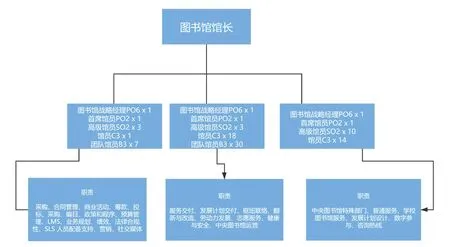
图1 组织架构

图2 服务支持

图4 服务开发
以下为访谈的英文原文:
Building a Future of Cooperation, Sharing, and Digital inclusion——An Interview with the Chief Librarian of Leeds Libraries
Q:Let’s start with the question about COVID-19, which broke out in 2020 and obviously has greatly affected the world, so how did you and your library respond to it? Now the epidemic has been generally under control in many countries, and libraries around the world are gradually recovering services, what do you think is the biggest change that libraries have experienced since the outbreak of COVID-19? A:Our response to the COVID pandemic followed a similar path to that of many other library services across the country.Customer Support
Initially many of our staff were deployed into different roles to support the foodbanks and helplines. At the same time we were pivoting our service from a ‘face to face’ model of delivery to a digital offer. This included providing more resources for customers to access from home.
During the first period of lockdown, we picked up on an initiative being developed in other library authorities and introduced a ‘Keep in Touch’ project telephoning over 9,500 of our older customers to:
Keep them updated about what was happening in the library service
Support them to access the library service and other services and agencies digitally
Check that they knew where to get any other help or support as necessary (e.g. the COVID helpline)
We had some very positive feedback to this initiative which evidenced the real impact of the calls:
‘I had a telephone call this morning from yourselves just to check on whether I am alright and coping with the current lockdown; also to update me on the library services now available. It is a worthy initiative and did a lot for me. Please extend my thanks.’
‘You’ve got me hooked on the audio books. Ilisten to about two books a week. The great thing is you can do something else at the same time. I find it very relaxing. I do a lot of sewing and with earbuds in listening works well. Great variety of titles too.’
‘You are all doing a fantastic job. Thank you very much for all your hard work you Librarians are doing keeping us informed and reading during this horrible time.’
Quite a long chat with a customer who was very interested in eBooks, e-Magazines etc. and also Local & Family History “Thank you that was the nicest phone call I've had in days"
Of the Order and Collect service - ‘We wouldn’t have survived without it! We would have been climbing the walls.’
Customer support for developing digital skills
One of the biggest reveals of the pandemic was the extent of digital exclusion and the increased challenges our citizens faced including isolation from essential support, deteriorating mental health and financial hardship. This prompted us to review our digital support offer in Leeds libraries, which we have now rebranded as #Digital121.
At the heart of our #Digital121 service is the library enquiries telephone service which catches and directs requests for digital support received from customers and partner organisations and matches them to the most appropriate support and information available from within the service or through referral.
#Digital121 is a universal offer but we have targeted those with low digital skills who may have never previously had access to their own device and need support to use it more fully. A dedicated #Digital121 marketing campaign is focusing on our core offer of providing digital support and encouraging our citizens to get in touch so our librarian team can help them in developing their digital skills and confidence.
During the pandemic and current restrictions, we delivered this support remotely by telephone or Zoom. Between May 2020 and May 2021 we delivered over 200 support sessions.
We also invested in more digital resources, increasing our e-book catalogues and purchasing new resources such as:
Niche Academy – a range of free online tutorials from setting up an e-mail account or getting started with social media to helping you build your skills using our online resources, such as eBooks, business support and genealogy searches. There has been significant interest in this resource with tutorials accessed over 13,500 times since its introduction in April 2020.
Press reader – an e-newspaper service ‘PressReader’ via RBDigital, allows our customers to keep up to date with the latest news, free of charge. There were 634 downloads from install on 27th March to the end of March, with 137 different titles being downloaded including some worldwide newspapers, some of which are not published in English.
Feedback from customers about all these activities, digital support sessions and new resources has been very positive
“Accessing eBooks has been a lifeline. It is the best app on my phone now!”
“A wonderful service (eNewspapers) that I can still use from home”
“Delighted I can get on Ancestry at home”
“The librarians have been BRILLIANT - the resources are really very good and easy to follow!”
As we move out of restrictions, we will plan to extend our #Digital121 offer with the re-introduction of face-to-face support sessions alongside our remote offer. We will focus on delivering group sessions that support customers to manage their health and wellbeing, stay safe online, and research their local and family history. We will also be recruiting digital volunteers to support our delivery and build capacity.
Developing our Digital library offer – resources and online events/activities
The initial period of lockdown was marked by an explosion of digital content which at times seemed overwhelming. As well as introducing Niche Academy and e-Newspapers, in our role as information professionals,we used our specialist skills to create a new virtual library on our webpages, curating the best of our own online content and also signposting to some of the ‘best of what else’ was available on others’ websites.
We also curated information about quality resources for our partners in education and sent out a regular newsletter to schools.
In addition, we developed a whole new range of virtual activities aligned to the broader library purpose to inform, educate and entertain. Some highlights include:
British Library exhibition, ‘Unfinished Business: The Fight for Women’s Rights’
Later in the year, as part of our work with the British Library (BL) we curated a virtual exhibition and programme of events to celebrate the BL’s own exhibition, ‘Unfinished Business: The Fight for Women’s Rights’. Our online exhibition highlighted Leeds’ unique contribution to the campaign for gender equality and featured important books connected to the wider history of women’s rights. The exhibition spanned over 300 years from the poetry of Katherine Philips in 1669, through to the activism of the 1970s and 80s, culminating in the work of contemporary local spoken word artists. The weekend of events, created in partnership with the BL, included workshops, author talks and performances, and attracted over 800 people from all over the world.
To celebrate the exhibition Studio12 led a series of 5 poetry workshops and mentoring sessions with young poets and renowned literary activist, writer and playwright Khadijah Ibrahiim. The workshops explored women’s voices, activism and the fight for a fairer world. The participants’ poetry was transformed into spoken word performance films, which were showcased at a special live Spoken Word Showcase. The showcase involved a panel discussion between Khadijah and poet/activist Suhaiymah Manzoor-Khan, followed by a spoken word takeover by The Sunday Practice. We had 300 engagements via social media in the lead up to the Spoken Word Showcase, and over300 people tuned in. Our largest audience was in Yorkshire, followed by London.
BBC’s ‘Novels That Shaped Our World
We also took part in the BBC’s national ‘Novels That Shaped Our World’ project and one strand of activity explored the connection between games and storytelling. A programme of events that included a workshop on creating your own literary escape game, a talk on the real history behind some of the novels from the BBC’s Novels list, animation activities for families and a panel event discussing how libraries and museums can use games to engage new audiences, which all led up to a two day Games Jam. The Jam challenged people to design a digital or physical game inspired by the BBC’s Novels list, and the participants were given access to images from our special collections for inspiration.
Our headline event of the weekend was a live mixed reality performance by virtual reality artist Rosie Summers who brought the world of Narnia to life. The games that were submitted can be viewed on our itch.io page and all events were recorded and added to YouTube.
We also delivered a programme of activity based around Arts and Cultural activities.
Arts Activity: We ran workshops inspired by the artist Joseph Cornell’s ‘world in a box’ sculptures and assemblage art. In these workshops, we captured the feel of the novel, its story, journey or place by assembling items in a box. The resulting artwork can be viewed in an exhibition with our partners Space2.
Cultural Activity: We ran a number of activities on social media and with readers and writers groups across the city. We asked readers to share the novel that has shaped them on social media, challenging readers to read as many of the 100 titles as they can. For writers we set a number of writing challenges and participants could also attend a writing class led by local author Alison Taft. Work written by the participants is currently featured on our digital book platform and you can read more about it here.
Business & Intellectual Property Service
For some key aspects of our service we took a business as usual approach albeit digitally. For example during the last year our Business & Intellectual Property Service quickly pivoted their services to an online model, ensuring local businesses had continuous support during the pandemic. This included:
Intensifying messaging across social media channels and via partners to inform the local business community that the service would continue to be available to support businesses with their enquiries via email and telephone.
The team and our business advice partners moved face-to-face consultations into a telephone format that proved particularly popular leading to the addition of new sessions.
Online access to our business resources ensured that the team were able to effectively deal with enquiries via email and telephone. Customers needing to consult these resources were able to book on one-to-one Zoom sessions providing the option of screen sharing.
Our face-to-face event programme was moved to webinar format ensuring continuity of our full programme of support Business & IP Centre Leeds Events | Eventbrite
As businesses looked to adapt to new ways of working and marketing, our webinars also refocused upon these sought after areas. This included extra webinars focusing upon online selling, social media and our first Start-up Summer School.
A successful Reset. Restart programme of talks aiming to support businesses transform, future-proof or grow was developed in partnership with the British Library. This provided access to a range of new webinars and follow-up one-to ones with specialist advisors. Reset. Restart - The British Library (bl.uk) .One of our most successful Reset. Restart online events focussed on the music sector, which had been hit particularly hard by the pandemic. This online panel event, which was held in partnership with Manchester libraries, featured musicians and other representativesfrom across the sector and provided a lively discussion about how to cope and pivot moving forward. Over 120 people attended the event live.
Short film summary
Finally, we have created this short film about our activity during the past year or more. youtu.be/QfGwr2vW8tQ (Live from Tuesday 29 June)
Q:The BBC has reported about the tight budget of British public libraries in the past ten years, and the number of public libraries in the UK has dropped significantly during last decade. Have Leeds Libraries been affected by this problem? Did COVID-19 aggravate the funding dilemma of British public libraries? How should libraries respond?
A:There are currently 34 libraries across the city of Leeds and there have been no closures in recent years. However, as part of a Library Review (New Chapter) back in July 2011 – 2013, 16 libraries closed, 3 moved into community management and a further 3 small libraries also subsequent closed in 2015.
Many local authorities have faced a significant financial challenge for a number of years and the situation has certainly been exacerbated by the pandemic.
In the last financial year, Leeds City Council was required to make a significant budget saving and all services, including the Library Service, were expected to contribute to this saving.
However, rather than going down the route of further library closures, and in recognition of the fact that the 34 remaining libraries in Leeds all serve major communities we instead used a ‘lean thinking’ approach to deliver savings through more efficient working practices.
This has included:
A review of the staffing structure of the library service, creating a more streamlined structure and introducing generic job descriptions to enable flexibility.
A review of opening hours as part of a public consultation and then developing a more efficientpattern of rota hours for the staff team to align with the resulting new opening hours. The review of opening hours has included the removal of Sunday opening and there are now a significant number of libraries across the city which only have 1 late evening opening a week.
Reducing spend on books.
The introduction of more cost effective methods of service delivery, e.g. reducing the range of print newspapers and introducing e-newspapers.
I think it is important that libraries respond to budget challenges by thinking creatively about how back-office efficiencies can be achieved, rather than always reducing the number of libraries or resources.
However, with ever shrinking budgets it is becoming increasingly difficult to find the efficiencies and so I think it is crucial that library services use this time to clearly articulate the role that libraries can play in the Covid recovery and beyond.
In its publication ‘Libraries: An Essential Part of Recovery’, Libraries Connected identifies the five key areas where libraries can play a central role in meeting the needs of individuals and communities who may be struggling to overcome the effects of the Covid-19 crisis.
These are:
Economic recovery, with help and training for job seekers and entrepreneurs
Education support for children and SEND (special educational need) students who struggled to learn at home
Isolation mitigation for vulnerable groups and to help people to reconnect locally
Digital inclusion for residents who lack IT skills or have no access to the Internet
Cultural partnership to help local artists and arts organisations to continue their work.
We have adopted these five broad themes to inform and underpin our new Recovery Strategy in Leeds Libraries and will ensure all our activity is aligned with one or more of these key priorities.
Q:As we know Leeds Libraries are a librarygroup composed of several libraries, could you share with us about how this group runs efficiently, especially in terms of funding and personnel management? How does Leeds library cooperate with libraries in other regions of the UK and with those at the national level?
A:Leeds covers a wide geographic area and is the third largest city in the UK by population with around 780,000 people. This is reflected in the fact that we have 34 libraries across the city, which makes us one of the larger city library services (Manchester has around 24 libraries, Liverpool has 18 libraries, Newcastle has 14 libraries).
The city is currently experiencing strong economic growth. However, whilst there are some in the city who enjoy increased life expectancy, social mobility and better jobs, others in Leeds live in deepening poverty. Approximately 20% of the population in Leeds live in poverty.
It is this issue of poverty which has driven the development of a network of Community Hubs across the city. A Community Hub provides access to multiple services, including Library Services, from one building located at the centre of a district community. As a key partner in this combined service delivery model, we have a fairly unique model of management for the delivery of our Library Service in Leeds.
Essentially, we have a single ‘front of house’ team. This means that the staff in the local Community Hub and Library will provide help with accessing library services as well as supporting customers needing to access, for example, council services or benefit advice or support with finding a job.
This front line staff team is managed by our Customer Service colleagues, while I, as Chief Librarian, am directly responsible for the development and delivery of professional library services across the entire library network as well as the delivery of the front line service from Central Library (which is not included in the co-location model).
I have attached in Appendix 1 a copy of thestaffing structure for the team that I have under my area of responsibility. This team includes the service specialists (e.g. Business and Information Librarians) but also librarians who, while based under my area of responsibility, work out in community libraries delivering sessions such as children’s events, reading groups, digital support sessions and reminiscence sessions for older people.
But, as already outlined, in addition to these librarians managed by me, there is a team of frontline staff who are managed by Community Hub Managers.
The funding for the Library Service comes directly from Leeds City Council although as a service we are sometimes successful in securing additional funding through one-off grants for specific projects.
The public library sector in this country is an extremely well connected network and I think it would help to illustrate my answer with a brief outline of the wider governance arrangements for libraries in England.
Libraries are a statutory service under the 1964 Public Libraries and Museums Act which requires Local authorities to deliver a ‘comprehensive and efficient library service’.
The statutory responsibility for libraries lies with the Local Authority (in our case Leeds City Council) and it is the statutory duty of the Secretary for State for Culture, Media and Sport (DCMS) to superintend, and promote the improvement of the public library service provided by local authorities.
Arts Council England (ACE) are the development agency for libraries; although they do not have any statutory responsibility for libraries, their role is to support and encourage the development of libraries.
Libraries Connected (LC), formerly The Society of Chief Librarians, is a membership organisation made up of every library service in England, Wales and Northern Ireland. LC is partly funded by Arts Council England as a Sector Support Organisation for libraries, with a staff team and board of trustees. Its aim is to improve library services by developingand sharing best practice, driving innovation and connecting partners to local libraries. Heads of Library Services regularly meet in their regional clusters, as members of Libraries Connected, to discuss information from, and provide feedback to, the LC Trustees and Advisory Board, as well as to discuss issues pertinent to the region.
So, whilst we operate as a Library Service at a local level within our own authorities, we are also connected through our networks, at a sub-regional level (for Leeds this is West Yorkshire), a regional level (for Leeds this is the Yorkshire and Humber region) and at national level through Libraries Connected.
I am currently the Chair of the Libraries Connected Yorkshire and Humber region which has 15 local authorities in the group.
We are increasingly working more collaboratively at this wider regional level – for example in the area of procurement. This has involved the development of a single framework to procure a Library Management System for the region.This will ultimately allow us to share our resources across our boundaries.
I also work closely with my local authority neighbours in West Yorkshire.For example, we have recently collaborated on a proposal for a funding bid which, if successful, would allow us to develop an enhanced digital offer to support digital inclusion across West Yorkshire through the library network.
As Chair of our local region, I am our representative at the national LC Advisory Board. I also represent the region on one of the national LC sub groups: Books and Reading.
As one of the city based library authorities we are also involved in partnerships with the British Library (BL), particularly through the Living Knowledge Network and the Business and Intellectual Property Network.There are some exciting plans for the BL to establish a BL North in Leeds and so we will be working even more closely with our national library over the coming months.
Q:We know that Leeds Central Library holdsLeeds Art Gallery, and provides services such as Art Library and Music Library. From your perspective, how does a library connect with a gallery, or in a more general sense, what’s the relationship between library and art or music? How did they come together in Leeds Libraries?
A:Leeds’ Central Library and the City Art Gallery are separate but adjacent buildings managed and operated by different areas of Leeds City Council, the Library Service and the Museums and Galleries Service, however they do have both a physical and historical connection, and often collaborate on joint projects. The long-standing connection between the two services is also illustrated through location of the City Museum on the first floor of the Central Library building until 2000.
The physical link between the adjacent buildings is evident in two places.There is a door for customers to move between the buildings at first floor level, bringing a direct connection for visitors to the upper galleries of the City Art Gallery into Central Library’s Art Library.On the ground floor, the beautiful Tiled Hall, which at one time has been the Library’s main reading room and has also housed the City Art Gallery’s sculpture gallery, and is now the Café accessible to the visitors to both buildings.
Art Library
The Art Library is a unique specialist library within a public library setting, one of just a few in the country. Originally located in the City Art Gallery building, the service began in 1956 as the Leeds Print Room and Art Library and was jointly managed by Leeds Libraries and the City Art Gallery. The library brought together the city’s valuable collections of watercolours and prints and 13,000 art books from the Reference and Central Lending Libraries; the books covered aesthetics, architecture sculpture, painting graphic and decorative arts.
Over the years, the Art Library outgrew the space and the books became hard to access. Therefore, when the City Museum’s collections were found a newhome in 2000 the first floor then became the Arts Floor we now know it, with the Music Library at one end, Art at the other and space for exhibitions and events in between.
A recent example of partnership working with the City Art Gallery is the support provided by their staff teams for the development of our relatively new Drawing Room (an art and craft studio) within the Art Library.
Due to the challenges of Covid-19 launched online in May 2020. Co-hosted by Leeds Art Gallery and the Art Library, each month we bring a Virtual tour of the exhibition and make books accessible via Libraries Borrow Box or pdfs. The Art Lovers Book Club (ALBC) brings thought provoking books chosen by artists. These books are all texts that have been particularly formative or influential on the artist's thinking or practice. The artist-selectors are always either exhibited in the gallery or represented in the Leeds Art Gallery Collection. ALBC has brought together diverse reading from the outstanding fiction of Virginia Woolf and Toni Morrison to books on erupting volcanoes, Maori culture, walks and trespass, nature, mycelium and mushrooms.An average of 40 people attending the monthly meetings.
Music and Performing Arts Library
The Music Library opened as a separate subject department in the Central Library in 1950. On opening, the library had 7,500 music scores and books and by 1969 the stock had grown to 33,000 copies of books, scores and manuscripts and 10,000 records, covering Jazz, Classical, Folk, Musical and non-musical works, such as drama poetry and language records.
The book stock has developed and we now have a specialist collection of over 10,000 items with a wide range of resources for both teachers, students and hobbyist.We also house current music periodicals and an extensive, and in some cases rare, back catalogue of bound journals dating back to 1800s and some earlier.The current collection also holds around over 6,000 CD titles covering all genres and boasts a veryextensive classical selection.
In 2012, the Music Library rebranded as the Music and Performing Arts Library and became home to 12,000 drama scripts from the Yorkshire Library and Information Service and then in 2016 the collection expanded yet again taking in the vocal and orchestral side of the same collection. The set lending service now boasts 3,000 orchestral sets and over 300,000 vocals sets, which are available for loan to groups throughout the UK.
Studio 12
The Arts Floor is also home to Studio12 where art music and design come together in a long established young people’s project situated in between both libraries and of course next to the gallery. This project encapsulates how music and art collide in Leeds libraries. The planned refurbishment of the Music Library will see ambitious and exciting programming to engage a diverse audience to access the resources, learning, collaborative social spaces and cultural opportunities.
Q:As we know, Leeds Central Library is a famous historical building.When it was originally designed, the concept of "business" (where local people came to settle their gas, water and rates bills) was well integrated with the concept of “popular” (Free Public Library).Do you think this kind of space compatibility still makes sense in the design of modern urban libraries?
A:Leeds Central library is a magnificent Grade 2* listed building.It opened in 1884 as part of a Municipal Building which provided a place for all the services previously spread across the city with the objective of concentrating the administration of Leeds between the Municipal Building and the Town Hall which had opened in 1858.
Central Library today occupies the entire space of the original Municipal Building, other services having long since moved into the city’s Civic buildings.However, what is interesting is that in many of the community libraries today offer a similar service.
As outlined in my answer to question 3, in Leeds, our library service is part of the Council’s Customer Service team, which has a specific focus on tackling poverty.As a response to the need to address poverty and deprivation in the city, as well as the need to deliver budget savings while ensuring the sustainable delivery of services, proposals were made in 2014 to develop a network of Community Hubs.
Libraries are an integral partner in this development and as such have ceased to be a standalone service.The Community Hubs bring together all existing community based libraries, one stop centres and housing management offices to be managed as a single set of front of house services.Whilst there is a clear focus on tackling poverty and inequality, the development of the Hubs also has a broader aim of providing trusted places in local communities – places where local people can access the whole range of council and partner services in an easy and integrated way.
This approach is entirely consistent with the role of libraries, which are often referred to as ‘community hubs’ themselves, providing a focal point within local communities and offering safe and welcoming spaces for people to come together and access a range of services.
For many, the local library, with friendly and well-trained staff who are close to their communities, also provides the connection to local decision-making and wider council services.Library Staff are able to help and support with a range of enquiries, providing information about statutory requirements and services relating to housing, health, education and other welfare provision or signposting to other services and agencies as appropriate.
For those who are not in contact with other major council services, such as education or social care, the library service is often the key point of contact / interface with the council and so libraries can, and do, play an important role in shaping opinion about the local authority in the community. With almost threemillion visits each year the frontline staff team members are well placed to act as positive ambassadors for the city’s values, vision and aspirations.
As trusted places at the heart of the community, our libraries are central to the design of the Leeds Community Hubs model. We continue, like other library services to offer welcoming, non-stigmatised, free and accessible spaces, where people can meet, engage, interact, learn and develop.Through our activities, our resources and our programmes of events, our libraries can play a key role in the early intervention and prevention agenda.
Q:In 2018, the 26th annual meeting of EBLIDA (European Bureau of Library, Information and Documentation Associations) proposed the theme of “libraries bridging borders”, how do you understand the term of “border”?
A:I would interpret ‘border’ in the widest sense.
As outlined in my earlier answer, the library network is a well-connected, cohesive network.This means that we work collaboratively as a profession at a local, regional, national and international level, supporting the development of our services and staff through sharing best practise while also supporting customers from outside the local area with their information needs.
Q:In your career, how the public libraries have changed compared with the past? What is your point of view about the future of public libraries? What is the biggest challenge we are or will be facing? How do you think librarians should adapt to the future development? In what aspects should we improve most urgently?
A:I started my first job after graduation in 1983 and it is really hard to describe how different the environment in which we operate today is.
A few memories I would like to share, which illustrate the extent of changes since I began my career, include:
At the small community library where I worked in the early 1980s I remember lots of large print andwestern books; paperback books (less popular than hardbacks) were filed in random order called ‘dumps’.
There were large collections of vinyl records – when someone wanted to join the service to borrow these records, they had to bring in the stylus of their record player for it to be checked; I was disbelieving when the music librarian said that vinyl records would soon be a thing of the past and we would all have CDs.
Videos (VHS) were just being introduced, but computers in libraries as we know them today were absolutely a thing of the future - although by the late 1980s we had a ‘have a go micro’ in our central library (but just the one!).
Issuing and discharging books was all done manually using the Browne issuing system.
The Net Book Agreement was in place and so approaches to stock selection and purchasing were very different from today, involving lots of book selection meetings and visits to library suppliers.
Staffing structures looked very different – with more specialists and specialist services but in the late eighties and early nineties there was very little investment in library environments, furnishings or fittings.We painted library shelves ourselves to brighten things up and there was great excitement when money was eventually found for a new carpet in one library to cover the parquet flooring!We are now restoring parquet flooring in many of our libraries!
There are some who predicted that there would be no future for libraries, and that the advent of e-books would remove the need for libraries; but libraries have proved themselves to be resilient and adaptable.
Books and reading are still very much at the heart of our offer and this I believe that this will continue to be a key aspect of library services into the future, given the resurgence of in interest in reading post-Covid and the proven wellbeing impacts of reading (e.g. just 6 minutes reading reduces stress and anxiety).
A crucial part of our offer now and in the future will continue to be the physical space. Libraries provide a safe, welcoming non-stigmatised space in theheart of the community, a space that is open and free for everyone to go to; a space that belongs to everyone in the community. It is a space for connections as well as collections. A place where people can meet, engage, interact, learn develop and share– share the space and share the resources helping to build the sense of trust which is so vital for community cohesion and the wider place making agenda
But, the library contribution to place making is not only about the building, it is also about the activity that takes place in the building – it is about how the space is used.
In Leeds, we have been investing in the refurbishment of our library spaces as part of the Community Hub programme. A key feature of our refurbished spaces has been building in the capacity for social and cultural events – in addition to space in the children’s library, small groups can comfortably meet while the library is open and some shelving is mobile to allow for larger cultural events out of hours.
An important aspect of the library service and possibly even more so in a post-Covid environment is our programme of services, events and activities. Whilst providing access to books and other resources is central to our offer, our libraries are also lively places with events and activity which, in turn, has the potential to help increase footfall in neighborhoods, supporting economic recovery.
In terms of future challenges, ensuring investment continues to be made into library services is critical – both in terms of capital infrastructure so that our library spaces are welcoming, bright, attractive and relevant but also in terms of the staffing required and funding to enable the delivery of a high quality programme of events and activities to engage the whole community.
And, to ensure this continued investment, we need as a profession to be developing a clear and strong narrative about how our library services contribute to 7 key outcomes as outline in the Government’s report Libraries Deliver: Ambition for Public Libraries inEngland 2016 -2021.
‘Ambition’ outlines the vision for the future development of public libraries and describes how library services in England can help transform lives, communities and society.It identifies seven key outcomes that libraries deliver against and which are critical to individuals and communities:
cultural and creative enrichment
increased reading and literacy
improved digital access and literacy
helping everyone achieve their full potential
healthier and happier lives
greater prosperity
stronger, more resilient communities
It is important that we ensure that all our activity aligns with these key outcomes as well as local plans and priorities.
Q:We also want to talk about the technology, more specifically, the library digitization, an issue frequently discussed. Do you think people’s understanding about digitization has been changed after COVID-19? In the next stage of development, what Leeds Libraries plan to do in terms of new technology application and digitization?
A:‘Digital access and literacy is increasingly critical, especially to central and local government strategies around economic development, channel shift, reducing social isolation and creating community cohesion’.
Across our city, with a population of 780k, tens of thousands of adults are offline or have very limited digital skills:
90,000 adults in Leeds are without essential digital skills
50,000 are not online at all
40% of council housing tenants are not online
Research shows that those who are digitally excluded also have poorer health and that by improving digital inclusion we can combat some of these health inequalities.
There are three main barriers to digital inclusion:
Lack of skills/confidence
Limited or no access to equipment/connectivity
Not motivated to get online/not understanding of the benefits of being online
Providing support for digital access has been at the heart of library services since the introduction of the People’s Network back in 1997.We currently have provide free access to computers, the internet, free wi–fi, and a tablet lending scheme providing iPads and 4G connectivity, and we also have a skilled staff team of Digital Champions who are able to support customers with the motivations and skills development through our free training and support programmes.
The Covid-19 pandemic has emphasised the importance of digital access and a blog from the Joseph Rowntree Foundation highlighted the impact that the closure of library buildings, especially in the first period of lockdown, had on digital inclusion for some of the most economically disadvantaged people in our communities.
These impacts included:
More people were required to access essential services digitally, for example to access health information, do their grocery shopping, access online bank accounts, or make contact with the council about their housing.Many people did not have the necessary skills or equipment, and may previously have visited a library to learn the skills or to access the equipment, and these services were simply not available.
More people with some digital skills found themselves needing to operate in a new way, for example replacing face to face work meetings, doctor consultations, and attendance at social clubs with their virtual equivalent, such as Zoom or MS Teams, and many had never needed to do this before, and although had some digital skills they needed to learn new ones.And obviously for those with no skills or equipment – this was an even greater challenge.
More people who were at risk of, or vulnerable to, the impacts of social isolation on both their mental and physical health have suffered during the pandemic.
In response to these challenges we introduced and further developed the service initiatives outlined in my response to Question 1.As we move towards the full reopening of our buildings we will take the learning from this experience to develop our services further.
For example, we have also identified, as a priority, the development of our community libraries in Leeds as Digital Hubs. The concept will include the introduction of Digital Health Hubs which use community engagement to reach poorly served groups and support access to digitally enabled health care and wider wellbeing.We will also be exploring the concept of libraries as data hubs.
Many of our activities moved online during the pandemic.As we reopen we will not be withdrawing these online offers, but instead we will be reviewing how they might work as a blended offer of both ‘in person’ and online. For example, we have been running Lego activities online rather than in our libraries. Before the pandemic these were only run in our libraries and some children were unable to attend because of the times/locations of the sessions.Once things start to operate more normally we are likely to continue to do both. In contrast, we moved to an online newspaper offer in the absence on hard-copy newspapers being available in our libraries; we may choose to maintain the online newspapers because of the range of titles available, the language translation functionality, and the ability of multiple readers to access a title simultaneously, rather than re-introduce hard-copy newspapers once more.
Q:For public libraries, serving diverse and disadvantaged groups is an important mission, and we know Leeds Libraries have already abolished fines for overdue library books since 2019. Some Chinese public libraries have also carried out similar actions. Could you present the effects or results of Leeds Libraries waiving overdue fines? In terms of serving disadvantaged and diverse groups, what other measures have Leeds implemented?
A:The first Library Service to abolish fines in theUK was Trafford in Greater Manchester in 2018. The change was in line with Trafford Council’s ambition of ‘no-one held back no-one left behind’. The rationale was that ‘fines can be off putting for customers’ and abolishing fines would remove one of the key barriers to access libraries. This in turn would lead to an increase in usage across the service.
Other authorities followed this example, including Leeds in Autumn 2019. Unfortunately we have been unable to review how the initiative this as we had planned to at the six month stage as we went into lockdown early in 2020.
Anecdotally however, we are not aware of any major issues and certainly Trafford who have been doing the scheme longer have not reported any adverse impacts.
Other activities to support disadvantaged or diverse communities.
The role played by community hubs, of which libraries are an integral part, tackling poverty is covered in my responses to questions 3 and 5.Some specific examples are outlined below:
Tablet Lending – The Library service operates a tablet lending scheme to help tackle the barriers to digital inclusion of access to equipment and connectivity, which is often exacerbated due to the cost of these resources and the data.We lend these devices to community organisations who use them to assist with training and support of their members/customers.With the help of additional funding from government bodies that support health and employment (e.g. the NHS and the Department for Work and Pensions / European Social Fund) we have increased the number of loanable iPads available (from approx. 300 to 600).These devices help to support the most vulnerable customers to stay connected with their health providers or to find work, etc.
Healthy Holidays cultural programme - Last summer, Leeds Community Foundation provided funding for the Healthy Holidays programme for schoolchildren in Leeds.The programme enablesvulnerable children to have access to food, fun activities, learning and support during the school holidays.Many of the activities had to be online. Because many of the children would struggle to take part in the activities because their families did not have access to a computer or network connectivity, we supported the programme through buying additional iPads for the tablet-lending scheme.We also created additional literature for the families to support their use of the device and accessing additional learning resources whilst the tablet was on loan to them.
Our new service plan will be looking to ensure that all our activities embrace equality, attracting and supporting the diverse communities living and working in Leeds.
Q:The "Library Manifesto for Europe" (2019) put forward the manifesto that ‘Libraries matter for Europe and Europe matters for libraries", so in what aspects do you think urban public libraries could make efforts to better serve the city’s development?
A:The manifesto sets out requests in six key areas for libraries and their users, and these cover the work of libraries in supporting education and skills, research and innovation and culture and heritage.
These areas are reflected in the Libraries Connected Universal Offers; these focus on the role of libraries in promoting access to reading, training, digital skills, trusted information and cultural experiences for people at every stage of their lives.In addition, LC have identified 5 key areas where libraries can play a central role in meeting the needs of individuals and communities who may be struggling to overcome the effects of the Covid-19 crisis. These are:
Economic recovery with help and training for job seekers and entrepreneurs
Education support for children and SEND students who struggled to learn at home
Isolation mitigation for vulnerable groups and to help people to reconnect locally
Digital inclusion for residents who lack IT skills or have no access to the Internet
Cultural partnership to help local artists and arts organisations to continue their work.
In addition, as outlined earlier in this document, libraries play an important role in the place making agenda. The library as a physical space provides a safe, welcoming non- stigmatised space in the heart of the community; a space that is open and free for everyone to go to; a space that belongs to everyone in the community. It is a space for connections as well as collections.
The President of LC has recently stated in the Libraries Recovery Document, “….communities need libraries to recover. They deliver tangible benefits to the local economy, educational outcomes and the health and wellbeing of all in our communities and especially the most vulnerable.Libraries are needed now more than ever”.
Libraries are a key part of the solution to outcomes that are important to local and national government and in supporting the post-Covid recovery.We have all the right ingredients in terms of our community based spaces, our skilled and knowledgeable staff teams and a rich and varied programme of activity aligned to priority outcomes. What we need to do is better articulate that provision to ensure we attract the funding necessary to maintain and extend our provision.
Appendix: The structure of Leeds Libraries
We have just completed a service review and are in the process of implementing a new structure to support our vision. Compared to our previous structure, the new one is a flatter, more manageable structure with just 5 tiers of staffing as opposed to the previous 11 tiers.
This new structure also introduces generic job descriptions enabling greater flexibility resulting also in the reduction of the number of job roles and job descriptions from over 40 in the previous structure to just 6 including the post of Chief Librarian.
The structure is split into 3 key areas; from left to right these are: Service Support, Service Delivery and Service Development.
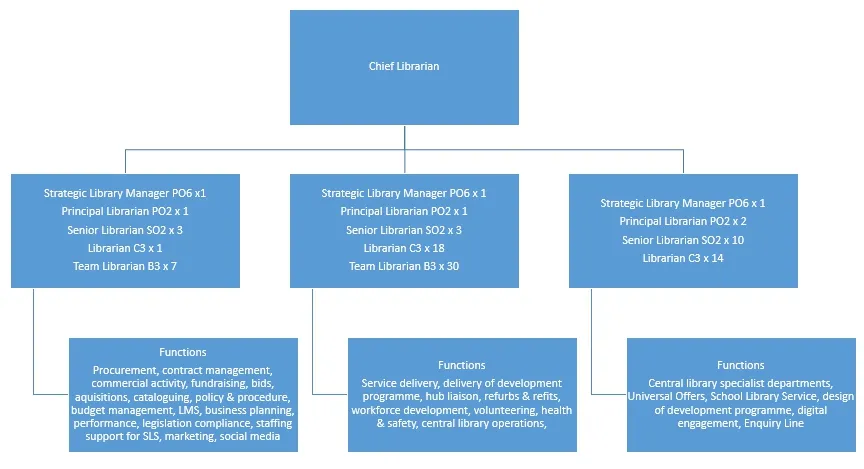
The structure of Leeds Libraries
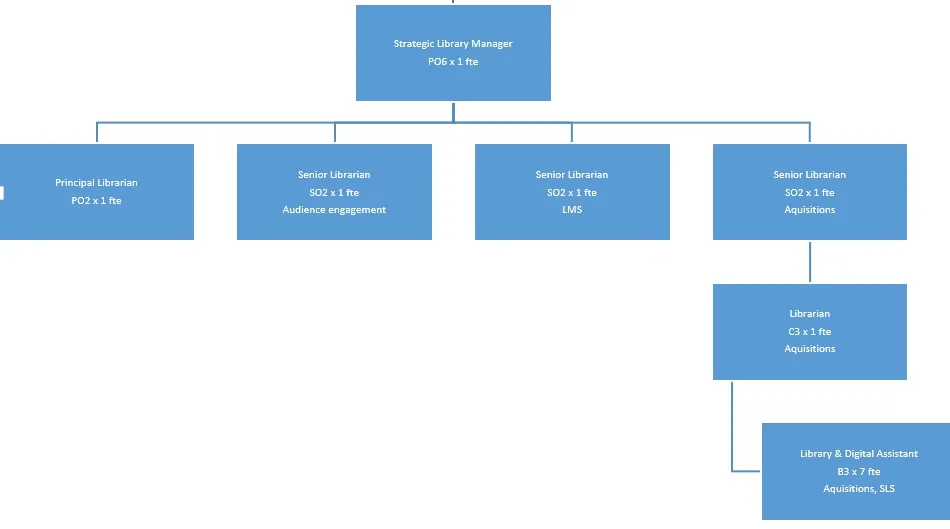
Service Support
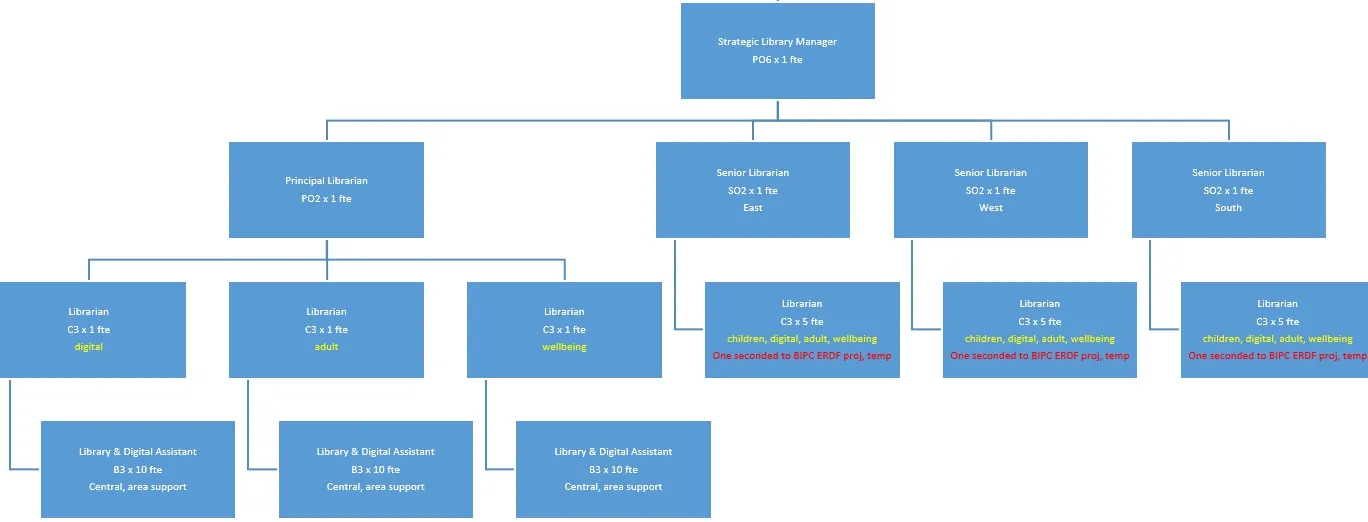
Service Delivery
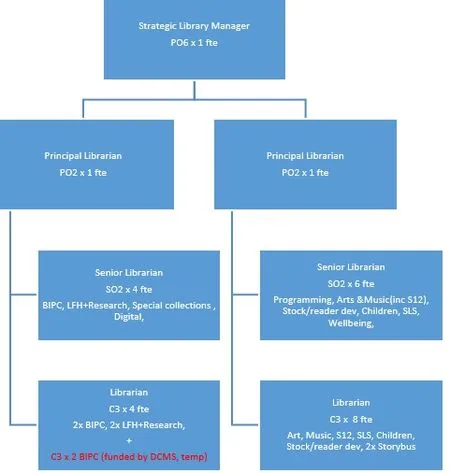
Service Development
注释:
① Libraries Connected。LC,英国艺术委员会支持的慈善性质的公共图书馆会员组织,由英格兰、威尔士和北爱尔兰的图书馆服务机构组成。
② 12号工作室。艺术楼层也是12号工作室的所在地,它位于两个图书馆(艺术图书馆和音乐和表演艺术图书馆)之间,毗邻画廊。在这里,艺术、音乐和设计融合在了一个历史悠久的面向年轻人的项目中,也展示了音乐和艺术是如何在利兹图书馆发生碰撞的。音乐图书馆的翻新计划将让人们看到更多雄心勃勃且令人兴奋的项目,以吸引不同的用户访问资源、学习、在社交空间中合作,并且获得更多的文化机会。
③ The Sunday Practice。利兹的一个现场音乐和诗歌之夜活动。
④ 这是一种在计算机技术出现之前在图书馆使用的借阅系统,该系统主要基于卡片,借书时,图书馆员拿走读者的一张借书卡,并取出书中的借书卡,两张卡放在一起按日期归档;归还图书时,将读者的借书卡从相应日期的档案中取出交还给用户,并重新将借书卡放入书中。
⑤ 英国和爱尔兰出版商协会和书商之间的一项固定图书价格协议,规定了图书向公众出售的价格。
⑥ People’S Network。一项由英国公共图书馆联合提供的服务。
